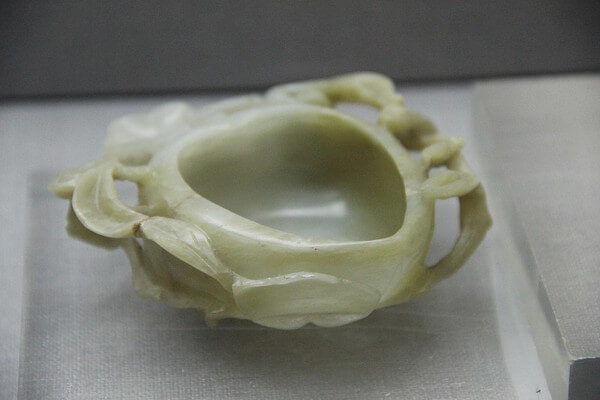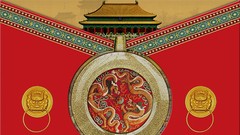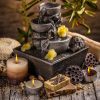
Jade has been a very important part of the Chinese tradition, and the history between the Chinese culture and jade has been recorded for a very long time and can be traced back to as early as the Neolithic era (10,000–4,500 BCE) with records showing how the ancient Chinese during the period has worn jade accessories and ornaments.
Also, with its natural hardness, jade has also been used to make various weapons in ancient China. Various excavations have earthed jade swords and spears in various places in China, dating back to the Neolithic era.
In this post, we will learn the long history of Chinese jade, why jade is so important in Chinese traditions, how to tell if your Chinese jade is real, and other things you may need to know about jade and its relations with Chinese culture.
Without further ado, let us begin.
Chinese Jade Throughout the History of China
Neolithic Period (10,000–4,500 BCE)
While there are various findings that can be dated back to this era, it’s very difficult to identify the specific dates of when these jade items were made. However, there are historical records that can help explain how jade was used during this period.
Jade ornaments found around the Yangtze river were speculated to be a part of the Majiabang Culture (5,100-3,900 BCE), and there have also been jade discoveries with remarkably sophisticated carvings that are believed to be a part of the Qinliangang and Songze cultures.
The techniques and methods used to carve jade ornaments continued to develop, and thus, the discoveries dated to the period of Liangzhu Culture (3,400-2,200 BCE) are much more complex and sophisticated in design, but many are with apparent lack of practical usage. It is believed that most jade ornaments and objects during this period were only used for ceremonial purposes.
Shang Dynasty Period (1,600-1,046 BCE)
Entering the Shang Dynasty period, jade became a widely popular material for various purposes. Various types of jade are used to make accessories and ornaments that were often worn in day-to-day fashion during the era. The shape, patterns, and carvings on these jade ornaments have also become more sophisticated and beautiful, and thus jade accessories became the common attire among Chinese women in the era, especially for noble ladies.
Ceremonial swords made of jade were also commonly used in this era, especially given by the Emperor to generals, nobles, and deserving people as gifts for their achievements.
Zhou Dynasty (1,046-251 BCE)
Entering the period of the Zhou Dynasty, jade became even more widely popular. The designs and ritual forms used in the Shang Dynasty were maintained but the use of jade ornaments in rituals became more systematized. Jade ornaments and especially scepters with different shapes were used to signify the ranks of the nobles, as well as a symbol of authority used by generals and the nobility to mobilize troops, declare peace, settle disputes, and other authoritative functions.
However, by middle Zhou times, the designs and functions of these jade objects became somewhat less systematic with abstract meander patterns. During the Eastern Zhou period, however, the introduction of iron tools allows more freedom in carving the jade materials, so jade can now be shaped into a great variety of animals, plants, and birds.
Nevertheless, jade in this era was a relatively expensive commodity, so they were only owned by nobles and rich people in the era.
Related reading: “Chinese Porcelain – Types, History, Identification” –Opens in new tab

Han Dynasty (202 BCE-220 CE)
Entering the period of the Han Dynasty, jade craftsmanship once again has undergone significant developments. In this era, jade accessories and ornaments that feature mythical beasts designs (phoenix, dragon, etc.) started to become common. The application of jade accessories also became more diverse, with people started using jade as a material to make belt buckles, buttons, and other smaller accessories.
Song Dynasty (960-1279 CE)
Entering the Song Dynasty period, the shapes and designs of jade ornaments did not undergo any significant changes, but archaic jade carvings have become much more popular. Many of these archaic designs adopted the styles from older periods, especially the Warring States and Han Dynasty periods. The more developed skills and technologies combined with adaptations with the older cultures have allowed various unique designs and shapes that have become the signatures of this era.
Qing Dynasty (1644-1911 CE)
The last dynasty before China enters the Republic era, and during this period, the designs, shapes, and sizes of jade accessories have become very diverse. Jade ornaments in China during this period didn’t only originate from China, but also from various other places all around the world.
During this period, jade wasn’t only used as fashion items, but also for various tools and everyday equipment like mugs, bottles, bowls, and so on. However, due to the price of these tools, only rich people during this era can afford them.
Jade’s Meaning in Chinese Culture
Throughout its long history, Chinese people have changed their views about the meaning of jade in their culture.
As mentioned, originally jade was only treated as fashion items with relatively simple meanings. However, as culture and traditions developed, jade was viewed as a spiritual item, closely related to immortality and the human soul. This is mainly because of jade’s subtle and translucent green color. When combined with gold, they are often treated together as symbols for heaven.
Jade was also often treated as a royal gemstone, the symbol of the royal family and nobility. In Chinese, Jade is called 玉 or yù, which has a close relation to the character 王 (wáng), the Chinese word for ‘Emperor”.
Traditionally, Chinese people war jade throughout the Chinese New Year period to pray for happiness and good fortune, while also believed to protect its wearer from bad luck.
See some beautiful Jade home decor and jewelry products – Opens in new tab.

Chinese Jade Healing Properties
Jade is also believed to enhance the wearer’s positive energy and prevent various forms of illness.
Many people in ancient China, and even until today believe that jade has its divine healing properties that can improve their life quality. Many believe that they can improve the circulation of life force by wearing various accessories made from jade, which can, directly and indirectly, help the wearer in producing positive energy. This allows enhancements in healing and replenishment powers, while also encouraging positive emotions for the jade’s wearer.
There are also those that treat jade as a symbol of infinite wisdom and purity. Thus, by wearing jade accessories, it is believed that jade can open the flow of energy, opening the wearer’s inner sight and cleansing their energy to produce a clearer aura. This allows the wearer to feel more peaceful, stable, and serene, as well as encouraging the wearer to have a more positive point of view.
How To Tell a Real Jade from Fake Ones
Due to the value and popularity of jade accessories, it’s no secret that there are many fake jade imitations available virtually everywhere, and unfortunately, they are often marketed as the real thing.
So, if you are currently looking to get a real jade and don’t want to get tricked, below we’ll share some tips on how to check whether a jade is real or an imitation.
Let us begin:
- Checking the texture and color of the jade:
- A real jade’s texture is very smooth, and you should feel very comfortable touching one. An imitation, on the other hand, will feel like a glass or even plastic during touch.
- Regarding colors, a real jade has a more vibrant and translucent, very soft green, while a false jade tends to have a more solid green that also will have less luster when put under light. Also, the colors between both sides may not be consistent (one side darker/brighter than the other)
- Another key distinction between real and false jades is the colors and shapes of the ‘veins’. Real jades’ veins have more vivid colors, and the shape of the veins is more natural (randomized), and sometimes very abstract. On the other hand, imitation jade tends to have unnatural, more patterned veins.
- Various tests that can check the authenticity of your jade:
- Heat test: a fairly easy test to do, you just need to grab the jade inside the palm of your hand. If it’s real jade, it should remain cool and not warm, while false jade will turn warm just like when you hold a regular glass.
- Hardness test: in this test, you only need to use simple metal tools like a key or a needle, and try scratching this thin and relatively sharp tool to your jade accessory (you don’t have to scratch it very hard). Real jade is solid and hard, and won’t scratch easily. If it does, then it’s likely it’s an imitation.
- Weight test: real jade is noticeably heavier than false ones because jade is a very dense material. To test this, try throwing a jade into the air and catch it. If it’s light, most likely it’s an imitation.
If after performing the tests above you are still not sure whether a jade is real, you can bring it to a professional jeweler or a jade expert so they can inspect it.
See some beautiful Jade home decor and jewelry products – Opens in new tab.

Chinese Jade: FAQ
What is Chinese Jade Used For?
Throughout Chinese history, jade has been used for various purposes: as accessories, ornaments, symbols of identity or role in the society, charms, ritual/ceremonial items, and part of clothing, among others.
Until today, jade is still treated as one of, if not the most important gemstone in China, and many Chinese people still believe that using accessories made from jade (in its various different shapes), will provide the wearer with good health and also ward off bad luck. Many also believe in the symbolist meaning behind jade, like immortality, protection against evil energy, and conveying beauty.
How Expensive is Real Jade and Why?
At the moment, the jade price can reach up to US$3,000 per ounce, making it a commodity more expensive than gold. As we know, China has undergone a massive economic surge in the past decade, bringing forth nouveau riches, increasing the demand for jade, and thus increasing the price.
What Color is Real Jade?
A common misconception is that real jade only comes in light green. While indeed green jade is the most common and also most sought after, there are also other natural jade colors like red, yellow, lavender, black, and even white.
The difference in colors doesn’t really affect the quality of the jade and doesn’t really affect the authenticity, but since green jade is more in-demand, it tends to be more expensive. Also, different jade colors should not affect hardness and density (or else, it might be an imitation).
What Does Chinese Jade Symbolize?
Jade is not only important in Chinese culture as an aesthetic item but symbolizes various values, cemented from the time of ancient China. According to the great philosopher Confucious, jade represents 11 important values: benevolence, justice, propriety, truth, credibility, music, loyalty, heaven, earth, morality, and intelligence.
When Did China Start Using Jade?
As mentioned above, jade has been used to make ornaments, accessories, and ritual tools since the Neolithic period, although how jade was used throughout this period was fairly simple. Throughout Chinese history, jade has been an inseparable aspect of Chinese culture.
Where Does China Get Its Jade From?
Until today, China is one of the biggest producers of jade in the world, especially green jade. However, for other types and colors of jade, countries like Myanmar also regularly export their high-quality jade to China.
How To Maintain Jade Accessories and Ornaments?
– Avoid using chemicals: although jade is one of the hardest materials with very high density, chemicals can damage the surface and discolor the jade. Jade is a rather sensitive material when it comes to chemicals, so avoid using any chemical supplies when cleaning.
– Use oil: you can use various types of oils, including incense oils to improve and maintain the jade surface’s luster.
– Use microfiber cloth: to avoid scratching the surface, use microfiber cloth while cleaning the jade accessories. A microfiber cloth will also help maintain the smooth look of the jade.
Online Courses about Chinese Culture from Udemy (Aff.link)

Stay in Touch
 Join our newsletter by using the forms on this website or click here!
Join our newsletter by using the forms on this website or click here! Follow us on Google News
Follow us on Google News Follow us on Facebook
Follow us on Facebook
Featured Image “jade.” by Pein3 is licensed under CC BY-NC-ND 2.0



